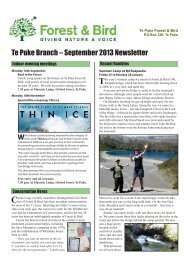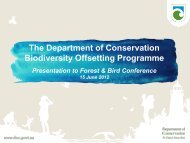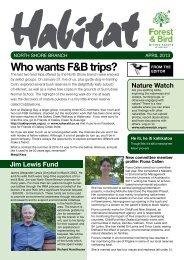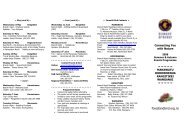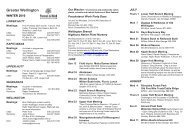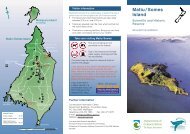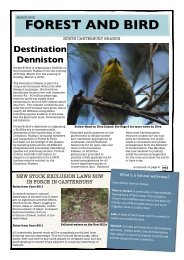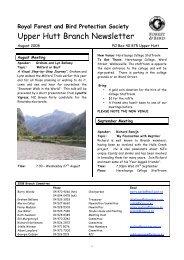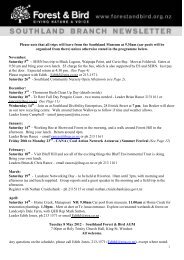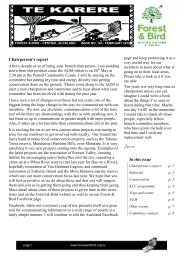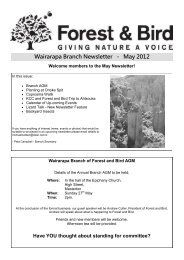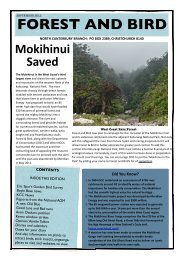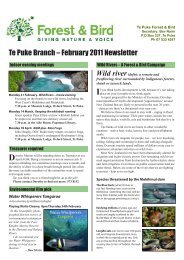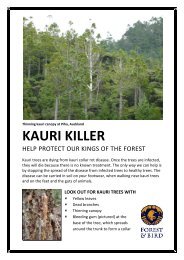methodology - Forest and Bird
methodology - Forest and Bird
methodology - Forest and Bird
You also want an ePaper? Increase the reach of your titles
YUMPU automatically turns print PDFs into web optimized ePapers that Google loves.
1. Introduction<br />
New Zeal<strong>and</strong> has one of the largest marine areas in the world, covering more than 1% of the Earth’s surface<br />
<strong>and</strong> 23 times our l<strong>and</strong> area. The marine areas of New Zeal<strong>and</strong> Exclusive Economic Zone (EEZ) <strong>and</strong> extended<br />
continental shelf are incredibly diverse. They range from the sub-tropical oceans in the north, to our<br />
temperate waters around the mainl<strong>and</strong> <strong>and</strong> cool sub-Antarctic waters in the south.<br />
Many of our marine species are found nowhere else in the world. Scientists estimate that more than 80%<br />
of New Zeal<strong>and</strong>’s biodiversity is found in our oceans (NZ Biodiversity, 2000), <strong>and</strong> much more is yet to be<br />
discovered. About 17,135 marine species are known from New Zeal<strong>and</strong> including some 4315 undescribed<br />
species in collections (Gordon et al., 2010). The total number of species in the New Zeal<strong>and</strong> marine<br />
environment could be well over 100,000 species (Gordon et al., 2010). New species are being discovered<br />
all the time, for example around 20 new fish species found each year (Gordon et al., 2010).<br />
Our marine area is also a vital part of our economy, supporting out $1.5 billion fishing industry <strong>and</strong> our $20<br />
billion tourism industry.<br />
It is also central to our national identity: most New Zeal<strong>and</strong>ers live near the ocean <strong>and</strong> have a close<br />
relationship with the marine environment. We collect kaimoana or seafood, swim, surf, dive, snorkel <strong>and</strong><br />
sail, <strong>and</strong> appreciate the variety of marine life.<br />
New Zeal<strong>and</strong> currently has 34 marine reserves (no-take areas), yet less than 1% of New Zeal<strong>and</strong>’s marine<br />
environment is fully protected.<br />
The Royal <strong>Forest</strong> & <strong>Bird</strong> Protection Society of New Zeal<strong>and</strong> Inc. (<strong>Forest</strong> & <strong>Bird</strong>) has a vision for New<br />
Zeal<strong>and</strong>’s fisheries. By 2030:<br />
We will have a healthy <strong>and</strong> diverse marine environment supporting an abundance of marine life,<br />
where profitable fisheries operate alongside other activities.<br />
Adverse impacts of fishing on the marine environment have been repaired or mitigated, <strong>and</strong><br />
“nursery areas” important for replenishment of populations are fully protected.<br />
New Zeal<strong>and</strong> meets or exceeds world’s best practice in fisheries management <strong>and</strong> environmental<br />
practice, so it can market truly sustainable products worldwide.<br />
This report presents the background <strong>and</strong> <strong>methodology</strong> behind the <strong>Forest</strong> & <strong>Bird</strong>’s Best Fish Guide - a guide<br />
to inform seafood consumers <strong>and</strong> encourage environmentally sound choices of seafood.<br />
The Best Fish Guide <strong>methodology</strong> was first developed in 2002, following extensive international research of<br />
similar fisheries certification <strong>and</strong> assessment methodologies (Weeber <strong>and</strong> Wallace 2008). The first Best Fish<br />
Guide was completed <strong>and</strong> published in November 2004.<br />
This report supports the 2012-2013 Best Fish Guide, representing the fifth edition of the guide. While the<br />
<strong>methodology</strong> has not changed significantly since the original version, it is updated with each review of the<br />
guide to reflect changes in available information.<br />
2. Why an Ecological Assessment?<br />
The main objective of any ecological certification or ecolabelling scheme is to create a market-based<br />
incentive for better management of fisheries. It does this by stimulating consumer dem<strong>and</strong> for fish <strong>and</strong><br />
other seafood products sourced from ecologically sustainable fisheries <strong>and</strong> well-managed stocks (Wessells<br />
et al., 2001, Deere 1999, Phillips et al., 2003).<br />
<strong>Forest</strong> & <strong>Bird</strong> Best Fish Guide 2012 – 2013: Criteria for Ecological Rankings 1



